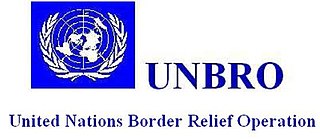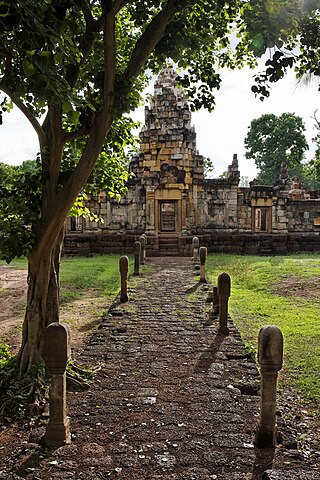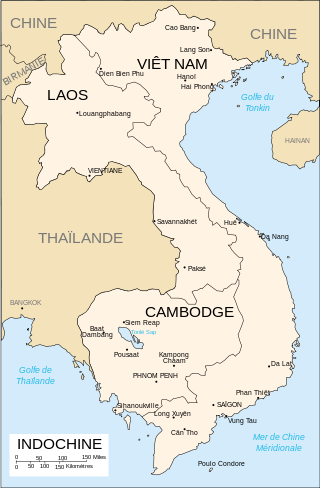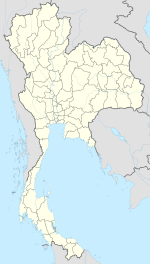
Montagnard is an umbrella term for the various indigenous peoples of the Central Highlands of Vietnam. The French term Montagnard signifies a mountain dweller, and is a carryover from the French colonial period in Vietnam. In Vietnamese, they are known by the term người Thượng, although this term can also be applied to other minority ethnic groups in Vietnam. In modern Vietnam, both terms are archaic, and indigenous ethnic groups are referred to as đồng bào or người dân tộc thiểu số. Earlier they were referred to pejoratively as the mọi. Sometimes the term Degar is used for the group as well. Most of those living in the United States refer to themselves as Montagnards, while those living in Vietnam refer to themselves by their individual ethnic group.

Cambodia, officially the Kingdom of Cambodia, is a country located in the southern portion of the Indochinese Peninsula in Southeast Asia, spanning an area of 181,035 square kilometres, bordered by Thailand to the northwest, Laos to the north, Vietnam to the east, and the Gulf of Thailand to the southwest. The capital and largest city is Phnom Penh.

The Thahan Phran AKA the Royal Thai Paramilitary Force is a paramilitary light infantry force which patrols the borders of Thailand and is an auxiliary of the Royal Thai Army (RTA) and the Royal Thai Marine Corps (RTMC). The Thahan Phran operate in conjunction with the Border Patrol Police (BPP), but are trained and equipped to engage in combat while the BPP is primarily a law enforcement agency. In Thailand there is a common name of black clothing unit (นักรบเสื้อดำ) or the Black Army due to their wearing of black uniforms.

The United Nations Border Relief Operation (UNBRO) was a donor-nation funded relief effort for Cambodian refugees and others affected by years of warfare along the Thai-Cambodian border. It functioned from 1982 until 2001.

The Cambodian–Vietnamese War, known in Vietnam as the Counter-offensive on the Southwestern border, and by Cambodian nationalists as the Vietnamese invasion of Cambodia, was an armed conflict between Democratic Kampuchea, controlled by the Khmer Rouge, and the Socialist Republic of Vietnam. The war began with repeated attacks by the Liberation Army of Kampuchea on the southwestern border of Vietnam, particularly the Ba Chuc massacre which resulted in the deaths of over 3,000 Vietnamese civilians. On 25 December 1978, Vietnam launched a full-scale invasion of Kampuchea, and subsequently occupied the country and removed the government of the Communist Party of Kampuchea from power.

The Khmer People's National Liberation Front was a political front organized in 1979 in opposition to the Vietnamese-installed People's Republic of Kampuchea (PRK) regime in Cambodia. The 200,000 Vietnamese troops supporting the PRK, as well as Khmer Rouge defectors, had ousted the Democratic Kampuchea regime of Pol Pot, and were initially welcomed by the majority of Cambodians as liberators. Some Khmer, though, recalled the two countries' historical rivalry and feared that the Vietnamese would attempt to subjugate the country, and began to oppose their military presence. Members of the KPNLF supported this view.
Alight, formerly the American Refugee Committee (ARC), is an international nonprofit, nonsectarian organization that has provided humanitarian assistance and training to millions of beneficiaries over the last 40 years.

Sdok Kok Thom, or Sdok Kak Thom, is an 11th-century Khmer temple in present-day Thailand, located about 34 kilometres (21 mi) northeast of the Thai border town of Aranyaprathet. The temple is in Khok Sung District, Sa Kaeo Province, near the village of Ban Nong Samet. It is regarded as the largest Khmer temple in eastern Thailand. The temple was dedicated to the Hindu god Shiva. Constructed by a prominent priestly family, Sdok Kok Thom is best known as the original site of one of the most illuminating inscriptions left behind by the Khmer Empire, which ruled much of Southeast Asia from the end of the 9th century to the 15th century.

The Khao-I-Dang (KID) Holding Center was a Cambodian refugee camp 20 km north of Aranyaprathet in Prachinburi. The longest-lived refugee camp on the Thai-Cambodian border, it was established in late 1979, administered by the Thai Interior Ministry and the United Nations High Commissioner for Refugees (UNHCR), unlike other camps on the border, which were administered by a coalition made up of UNICEF, the World Food Program, International Committee of the Red Cross (ICRC) (briefly), and after 1982, the United Nations Border Relief Operation (UNBRO). The camp held refugees fleeing the Cambodian–Vietnamese War.

The People's Republic of Kampuchea (PRK) was a partially recognised state in Southeast Asia supported by Vietnam which existed from 1979 to 1989. It was founded in Cambodia by the Kampuchean United Front for National Salvation, a group of Cambodian communists who were dissatisfied with the Khmer Rouge due to its oppressive rule of Cambodia and defected from it after the overthrow of Democratic Kampuchea, Pol Pot's government. Brought about by an invasion from Vietnam, which routed the Khmer Rouge armies, it had Vietnam and the Soviet Union as its main allies.
After the 1978 Vietnamese invasion of Cambodia and subsequent collapse of Democratic Kampuchea in 1979, the anti-Hanoi Khmer Rouge fled to the border regions of Thailand, and, with assistance from China, Pol Pot's troops managed to regroup and reorganize in forested and mountainous zones on the Thai-Cambodian border. During the 1980s and early 1990s Khmer Rouge forces operated from inside refugee camps in Thailand, in an attempt to de-stabilize the pro-Hanoi People's Republic of Kampuchea's government, which Thailand refused to recognise. Thailand and Vietnam faced off across the Thai-Cambodian border with frequent Vietnamese incursions and shellings into Thai territory throughout the 1980s in pursuit of Cambodian guerrillas who kept attacking Vietnamese occupation forces.
The earliest traces of armed conflict in the territory that constitutes modern Cambodia date to the Iron Age settlement of Phum Snay in north-western Cambodia.

The Khmer People's National Liberation Armed Forces (KPNLAF) was the military component of the Khmer People's National Liberation Front (KPNLF) a political front organized in 1979 in opposition to the Vietnamese-installed People's Republic of Kampuchea (PRK) regime in Cambodia. The KPNLAF was loyal to Son Sann, a former Prime Minister under Prince Norodom Sihanouk and the founder of the KPNLF political movement.
Sa Kaeo Refugee Camp was the first organized refugee relief camp established on the Thai-Cambodian border. It was built by the Royal Thai Government with support from international relief agencies including the United Nations. It opened in October 1979 and closed in early-July 1980. At its peak the population exceeded 30,000 refugees; no formal census was ever conducted.

Nong Samet Refugee Camp, in Nong Samet Village, Khok Sung District, Sa Kaeo Province, Thailand, was a refugee camp on the Thai-Cambodian border and served as a power base for the Khmer People's National Liberation Front (KPNLF) until its destruction by the Vietnamese military in late 1984.
Nong Chan Refugee Camp, in Nong Chan Village, Khok Sung District, Sa Kaeo Province, Thailand, was one of the earliest organized refugee camps on the Thai-Cambodian border, where thousands of Khmer refugees sought food and health care after fleeing the Cambodian-Vietnamese War. It was destroyed by the Vietnamese military in late 1984, after which its population was transferred to Site Two Refugee Camp.

The Indochina refugee crisis was the large outflow of people from the former French colonies of Indochina, comprising the countries of Vietnam, Cambodia, and Laos, after communist governments were established in 1975. Over the next 25 years and out of a total Indochinese population in 1975 of 56 million, more than 3 million people would undertake the dangerous journey to become refugees in other countries of Southeast Asia, Hong Kong, or China. According to the United Nations High Commissioner for Refugees, 250,000 Vietnamese refugees had perished at sea by July 1986. More than 2.5 million Indochinese were resettled, mostly in North America, Australia, and Europe. More than 525,000 were repatriated, either voluntarily or involuntarily, mainly from Cambodia.
The Cambodian humanitarian crisis from 1969 to 1993 consisted of a series of related events which resulted in the death, displacement, or resettlement abroad of millions of Cambodians.

The Cambodia–Thailand border is the international border between Cambodia and Thailand. The border is 817 km (508 mi) in length and runs from the tripoint with Laos in the north-east to the Gulf of Thailand in the south.

The Dangrek genocide also known as "the Preah Vihear pushback" is a border incident which took place along the Dangrek Mountain Range on the Thai-Cambodian border which resulted in the death of many mostly Sino-Khmer refugees who were refused asylum by the Kingdom of Thailand in June 1979.














